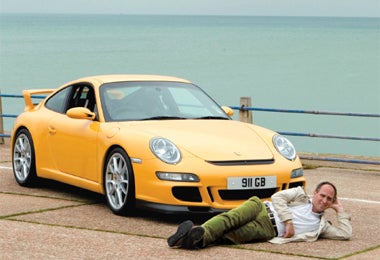Porsche 911 GT3
If you need a car with more speed than a Porsche 911 GT3, you either need a 911 Turbo or your head examined. Words by Michael Booth. Photograph by Teena Taylor

Price: £79,540 (plus extras)
Performance: 192mph, 0-60 in 4.3 secs
Combined fuel consumption: 21.7mpg
Further information: 08457 911 911
Many of you have written in pleading with me to clarify the bewildering range of options open to the Porsche 911 buyer (please, Mrs Bridges of St Albans, suicide is not the answer). So here goes:
At the bottom of the range is the bog-standard 3.6 Carrera, which costs just over £60,000 and is just about all the practical, well-engineered, user-friendly, depreciation-proof sports car you'll need. It is bought by intelligent people who like to drive fast occasionally without ending their days in a flaming comet of death.
If you are of a nervous disposition, you might want to cough up an extra £4,000 for the four-wheel-drive Carrera 4; the less nervous will want to spend big on a 3.8-litre version, at £71,980 (3.8-litre owners look down on 3.6-litre owners, judging them, rightly, as miserly milquetoasts). A little further up the range you can have the same car with a £3,000 " Powerpack". This is bought by men who have suffered genital mutilation, either at the workplace or in the whorehouses of Guildford.
At the top of the tree is the 911 Turbo, which is bought by the kind of people who inflict metaphorical genital mutilation on others in the corporate world and, quite probably, literally in their spare time as a hobby. The Turbo is ludicrously fast. Faster than anyone will ever need, or ought, to go. A car, in other words, for the mad and the bad. The dangerous to know, meanwhile, buy the genetically mutated GT3 RS, which is an insanely fast, super-light street-racer that will almost certainly creep up to your bedroom in the dead of night and kill you while you sleep.
So, where does the marginally less insane, 409bhp GT3 fit in to this? It costs just under £80,000, placing it a good £18,000 below the Turbo, yet it is still astonishingly quick. It is also brilliant fun: its throttle alive to the slightest input, its engine bursting with torque at any speed and in any gear, and brakes that can give you an instant facelift. Ignore, if you can, the fact that it is as ugly as pigs' doings; the GT3 perfectly balances the thrill of a track car with the refinement of a road car; the noise is just this side of tolerable, the ride goes easy on the spine and humans can just about control it. But the steering wheel and gear knob are not lined with super-absorbent, rough suede for nothing. Unleash the GT3's potential and the sweat will pour in buckets.
I have to say, though, that Porsche's options list – or rather its prices – does rather make a mockery of my meticulous analysis of the 911 family tree. Though it looks great value compared with the RS and Turbo, this GT3 came with £14,000 worth of extras, including almost £6,000 worth of ceramic brakes (a GT3 without them would be simply too embarrassing to contemplate); over £3,000 spent on lightweight bucket seats (which ought to be standard on a model pitched as a stripped-out track car); and another £1,600 on a lightweight interior (talk about less is more...). That takes it perilously close to Turbo territory. What did you say you did in your spare time again?
It's a classic: Porsche 911 Carrera RS
The 1972 911 Carrera RS still has the power to make grown men giggle and dribble slightly – and the reason is the RS – for Rennsport, or "motor/circuit racing".
Essentially a racing car in road guise with super-light bodywork made from thin steel and fibreglass, extra-thin glass and a stripped-out interior, it weighed less than 1,000kg. It was created as a road car to fulfil the requirements of the new FIA Group 4 class, which demanded that 500 road versions were built of any race car, with a larger 2.7-litre version of the classic air-cooled, flat-six engine and the signature side-decals and " duck-tailed" spoiler.
That was joined by the even more desirable RS 3.0, launched in 1974. Though their engines were far smaller, the Porsches trounced the competition from Ferrari and Corvette, winning the European GT Championship, the Sebring 12 Hours and Targa Florio.
Subscribe to Independent Premium to bookmark this article
Want to bookmark your favourite articles and stories to read or reference later? Start your Independent Premium subscription today.

Join our commenting forum
Join thought-provoking conversations, follow other Independent readers and see their replies